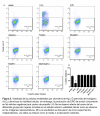Oxidative stress in endothelial cells induced by the serum of women with different clinical manifestations of the antiphospholipid syndrome
- PMID: 31860179
- PMCID: PMC7363350
- DOI: 10.7705/biomedica.4701
Oxidative stress in endothelial cells induced by the serum of women with different clinical manifestations of the antiphospholipid syndrome
Abstract
Introduction: The antiphospholipid syndrome is characterized by the persistent presence of antiphospholipid antibodies and clinical manifestations of thrombosis or gestational morbidity that are associated with oxidative stress and endothelial dysfunction. Objective: To evaluate markers of oxidative stress in endothelial cells induced by the serum from women with different clinical manifestations of the antiphospholipid syndrome, and to analyze the antioxidant capacity of the sera. Materials and methods: We included 48 women who were classified as follows: presence of antiphospholipid antibodies and clinical criteria of gestational morbidity alone, vascular thrombosis only, and gestational morbidity/vascular thrombosis. Control groups included antiphospholipid antibodies negative women. In an in vitro model of endothelial cells stimulated with sera from women included in the groups, some markers of oxidative stress were determined by flow cytometry. The antioxidant capacity in the sera of these women was analyzed. Results: The sera from the groups of women with antiphospholipid syndrome that presented thrombosis, with or without gestational morbidity, generated a significant increase (p<0.05 and p<0.001) in endothelial oxidative stress markers in contrast to the control of normal human serum. There were no differences in the effect of the sera from the different study groups on endothelial lipid peroxidation. Also, there was also no difference in the antioxidant activity of the sera. Conclusion: Mitochondrial oxidative stress in the endothelium is associated with the presence of thrombosis; instead, its association with gestational morbidity generates intracellular oxidative stress.
Introducción. El síndrome antifosfolípido se caracteriza por la presencia persistente de anticuerpos antifosfolípidos y manifestaciones clínicas de trombosis o morbilidad gestacional, las cuales se asocian con estrés oxidativo y disfunción endotelial. Objetivo. Evaluar los marcadores de estrés oxidativo en células endoteliales, inducidos por el suero de mujeres con diferentes manifestaciones clínicas del síndrome antifosfolípido y analizar la capacidad antioxidante de los sueros. Materiales y métodos. Se incluyeron 48 mujeres que fueron clasificadas así: presencia de anticuerpos antifosfolípidos y criterios clínicos de morbilidad gestacional, trombosis vascular o ambas. Como grupos control se incluyeron mujeres negativas para anticuerpos antifosfolípidos. En un modelo in vitro de células endoteliales estimuladas con los sueros de las mujeres del estudio, se determinaron algunos marcadores de estrés oxidativo por citometría de flujo. También, se analizó la capacidad antioxidante de los sueros incluidos. Resultados. Los sueros de los grupos de mujeres con síndrome antifosfolípido que presentaban trombosis, con morbilidad gestacional o sin ella, generaron un incremento significativo (p<0,05 y p<0,001) en los marcadores de estrés oxidativo endotelial, en contraste con el control de suero humano normal. No se observaron diferencias en el efecto de los sueros de los diferentes grupos de estudio sobre la lipoperoxidación endotelial. Tampoco se encontró diferencia en la actividad antioxidante de los sueros. Conclusión. El estrés oxidativo mitocondrial en el endotelio se asocia con la presencia de trombosis. Sin embargo, cuando esta se asocia con morbilidad gestacional, también se genera estrés oxidativo intracelular.
Keywords: Antiphospholipid syndrome; oxidative stress; morbidity; pregnancy; thrombosis; antioxidants.
Conflict of interest statement
Figures







Similar articles
-
Clinical characterization of antiphospholipid syndrome by detection of IgG antibodies against β2 -glycoprotein i domain 1 and domain 4/5: ratio of anti-domain 1 to anti-domain 4/5 as a useful new biomarker for antiphospholipid syndrome.Arthritis Rheumatol. 2015 May;67(8):2196-204. doi: 10.1002/art.39187. Arthritis Rheumatol. 2015. PMID: 25939498
-
Endothelial and platelet microparticles in patients with antiphospholipid antibodies.Thromb Res. 2015 Feb;135(2):368-74. doi: 10.1016/j.thromres.2014.11.027. Epub 2014 Dec 4. Thromb Res. 2015. PMID: 25496997
-
Antiphospholipid syndrome.Thromb Res. 2017 Mar;151 Suppl 1:S43-S47. doi: 10.1016/S0049-3848(17)30066-X. Thromb Res. 2017. PMID: 28262233 Review.
-
From antibody to clinical phenotype, the black box of the antiphospholipid syndrome: pathogenic mechanisms of the antiphospholipid syndrome.Thromb Res. 2013 Sep;132(3):319-26. doi: 10.1016/j.thromres.2013.07.023. Epub 2013 Aug 2. Thromb Res. 2013. PMID: 23958468 Review.
-
Autoantibodies against the fibrinolytic receptor, annexin 2, in antiphospholipid syndrome.Blood. 2006 Jun 1;107(11):4375-82. doi: 10.1182/blood-2005-07-2636. Epub 2006 Feb 21. Blood. 2006. PMID: 16493010 Free PMC article.
Cited by
-
Antiphospholipid Antibodies From Women With Pregnancy Morbidity and Vascular Thrombosis Induce Endothelial Mitochondrial Dysfunction, mTOR Activation, and Autophagy.Front Physiol. 2021 Nov 29;12:706743. doi: 10.3389/fphys.2021.706743. eCollection 2021. Front Physiol. 2021. PMID: 34912234 Free PMC article.
-
Obstetric Antiphospholipid Syndrome: An Approach from Glycans of the Immunoglobulin G.J Hum Reprod Sci. 2021 Jan-Mar;14(1):97-100. doi: 10.4103/jhrs.JHRS_21_20. Epub 2021 Mar 30. J Hum Reprod Sci. 2021. PMID: 34084001 Free PMC article.
-
Differences in Endothelial Activation and Dysfunction Induced by Antiphospholipid Antibodies Among Groups of Patients With Thrombotic, Refractory, and Non-refractory Antiphospholipid Syndrome.Front Physiol. 2021 Dec 2;12:764702. doi: 10.3389/fphys.2021.764702. eCollection 2021. Front Physiol. 2021. PMID: 34925061 Free PMC article.
References
-
- Cervera R, Serrano R, Pons-Estel GJ, Ceberio-Hualde L, Shoenfeld Y, de Ramon E, et al. Morbidity and mortality in the antiphospholipid syndrome during a 10-year period: a multicentre prospective study of 1000 patients. Ann Rheum Dis. 2015;74:1011–1018. doi: 10.1136/annrheumdis-2013-204838. - DOI - PubMed
MeSH terms
Substances
LinkOut - more resources
Full Text Sources

